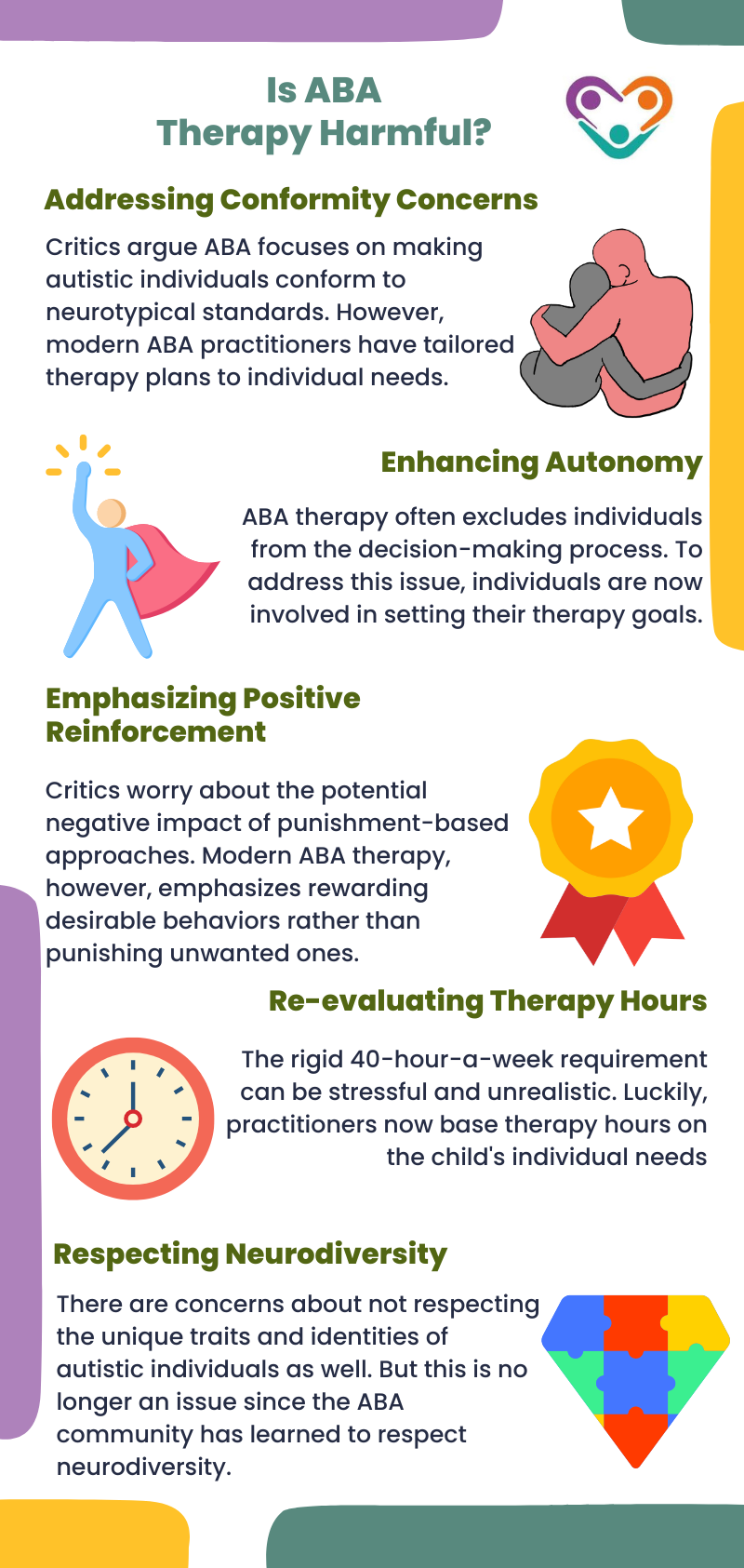As a young parent with an autistic child, you may have encountered various therapy options. One of the most prominent is Applied Behavior Analysis (ABA) therapy. But does ABA therapy work? Let’s explore what ABA therapy is, how it works, its benefits, and the controversies surrounding it to help you make an informed decision.

Understanding ABA Therapy
The roots of ABA therapy can be traced back to the 1960s when behavioral psychologist Dr. Ivar Lovaas pioneered its methods. Initially, Lovaas’s approach was intensive, often involving up to 40 hours a week of therapy focused on repetitive tasks and rewards. This early form of ABA also included aversive techniques like electric shocks for non-compliance.
Over the decades, ABA therapy has evolved significantly. Modern ABA emphasizes positive reinforcement rather than punishment, focusing on creating supportive and engaging learning environments. Today, the therapy is more flexible, ranging from 10 to 40 hours per week, and is customized to each child’s unique needs and circumstances.
Despite its widespread use and many success stories, ABA therapy is not without controversy. Some critics argue that its early methods were too harsh and that the therapy can sometimes feel like conditioning rather than teaching. They express concerns that ABA may push children to conform to social norms at the expense of their individuality.
Another point of contention is that ABA can be intensive and repetitive, which some parents and advocates feel can be overwhelming for children. Proponents of ABA, however, emphasize its benefits in improving communication, social skills, and independence. They argue that modern ABA practices are ethical, child-centered, and adaptable.
How ABA Therapy Works
ABA therapy is grounded in the principles of operant conditioning and respondent conditioning, which are employed to modify behaviors effectively:
- Operant Conditioning: This involves learning behaviors through reinforcement. For instance, a therapist might use a token system where a child earns tokens for completing tasks, which can later be exchanged for a preferred activity or treat.
- Respondent Conditioning: This entails linking a behavior to a stimulus. For example, a child may begin to associate the ring of a bell with changing between tasks, which will facilitate their easier transition to new routines.
Furthermore, ABA therapy employs various strategies to reinforce desired behaviors and reduce unwanted ones. Here are some real-world examples of actions taken by ABA therapy experts:
- Discrete Trial Teaching (DTT): A therapist works one-on-one with a child, breaking down tasks into simple steps and using repetition to teach skills. For example, if teaching a child to identify colors, the therapist might hold up a red card and say, “What color is this?” When the child correctly identifies the color, they receive immediate praise and a small reward, such as a sticker.
- Natural Environment Teaching (NET): This approach leverages a child’s natural interests and activities to encourage learning. If a child enjoys playing with building blocks, the therapist might incorporate counting and color identification into the play session. For instance, they might say, “Can you hand me the blue block?” reinforcing language and cognitive skills in a fun, engaging way.
- Positive Reinforcement: A therapist might use praise, access to favorite toys, or extra playtime to reinforce good behavior. For example, if a child completes their homework without prompting, they might earn extra time on the playground, encouraging them to repeat this positive behavior.
- Prompting and Fading: Initially, a therapist might use hand-over-hand guidance to help a child brush their teeth. As the child becomes more proficient, the therapist gradually reduces assistance until the child can perform the task independently. This method ensures that the child learns the skill without becoming overly reliant on prompts.
These real-world examples illustrate how ABA therapy experts tailor interventions to each child’s needs, making the therapy both practical and effective in promoting positive behavioral changes and skill development.

Is ABA Therapy Harmful?
As you can see, ABA therapy uses a scientific approach to understand and change specific behaviors by focusing on environmental factors and individualized learning styles. It also aims to improve social and communication skills. The question “Is ABA therapy harmful?”, however, still sparks a heated debate within the autism community.
Some advocates believe that ABA therapy focuses too much on making autistic individuals conform to neurotypical standards. For instance, behaviors such as stimming (repetitive movements or sounds) are often discouraged. Critics argue that suppressing such behaviors can harm an individual’s emotional well-being and sense of identity.
Another significant and widespread concern is that ABA therapy sometimes does not involve the individual in goal-setting and decision-making processes. This can lead to a feeling of loss of control and autonomy, as the therapy may prioritize socially acceptable behaviors over the individual’s personal preferences and comfort.
To address these concerns, many modern ABA practitioners have adapted their methods to be more compassionate and individualized. Instead of a one-size-fits-all approach, therapy plans are increasingly tailored to the individual needs and preferences of each child. This includes involving the child in setting goals to ensure that their voice is heard.
Modern ABA therapy also emphasizes positive reinforcement rather than punishment. This means focusing on rewarding desirable behaviors rather than punishing unwanted ones. For example, a child might receive praise and a small reward for successfully communicating a need, encouraging them to continue developing their communication skills.
The rigid requirement of 40 hours a week is being re-evaluated as well. Therapy hours are now often based on the child’s individual needs, abilities, and endurance, ensuring a more manageable and less stressful experience. Lastly, there is a growing movement within the ABA community to respect and celebrate neurodiversity.

The Takeaway
ABA therapy can be a powerful tool in managing ASD symptoms. While it has its share of controversies, many experts and parents have found it beneficial. As with any therapy, it is crucial for parents and caregivers to thoroughly research and consider their child’s unique needs and to work closely with qualified and empathetic ABA practitioners.
If you’re seeking specialized ABA therapy in New Jersey, Indiana, Georgia, and New York, Golden Care offers comprehensive services tailored to meet the unique needs of each individual. Contact us to learn more or book a consultation today.
Sources:



